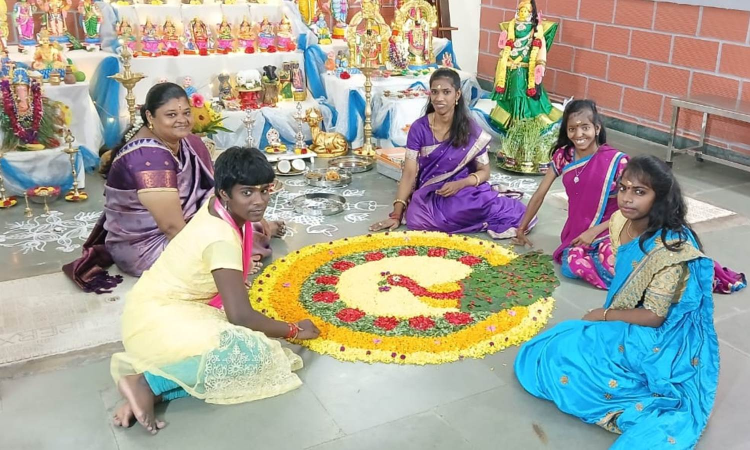Chennai Special Schools celebrate Navaratri with joy and purpose
Navaratri comes alive in Chennai’s special schools through clay dolls, music, sundal and laughter. Here, children of all abilities create, celebrate, and shine in their own beautiful way

At Sri Arunodayam home
CHENNAI: At Vasantham Special School in Mogappair East, festivals are more than just rituals. They are moments of joy, learning and celebration. Navaratri, in particular, holds a special place. The school has been setting up golu since 2000. What began as a small display inside a classroom has now evolved into a full-scale celebration, complete with student-made decorations and cultural performances.
Krupa, speech therapist and Executive Director of the school, shares that the children are involved in every aspect of the golu. “We have a traditional golu set-up, but alongside that, we also display a golu created by our students. They make clay models of miniature cartoon characters, idols and they take so much pride in it.”
The school welcomes students from as young as three years old to adults over 50. Through vocational training, students are taught crafts and skills that are integrated into festival preparations. Bags and pouches made in the training sessions are given to donors and visitors as return gifts during Navaratri.
“Some of the designs our students create are so detailed that even we adults find it hard to replicate them. We don’t follow a specific theme for the golu. We let the students choose. Sometimes it’s a sports theme, sometimes a village scene, or even something made with origami. It’s entirely their imagination," Krupa adds.
Throughout the Navaratri week, the school becomes a hub of activity. From making and distributing different varieties of sundal every day to singing, dancing, and pooja, the children are involved in everything. Many even help in the kitchen, and some conduct the pooja themselves.
“All of this helps improve their fine and gross motor skills. More importantly, it gives them a platform for expression. They also help clean up after the celebrations. The entire process is part of their learning," says Krupa.
At Sri Arunodayam, a home for children with intellectual disabilities who have been abandoned by their families, Navaratri has become a festival of pride and participation. Over the last three years, the home has celebrated with grandeur and purpose. Chitra, admin head, shares, “This year, we’re working on two themes: Kailaya Malai and Lord Kallazhagar entering the Vaigai river, inspired by the Chithirai festival. The dolls are sourced from outside, but the children set them up and decorate the space with the support of our staff. As they plan the sequence of dolls, remember where each figure belongs, and select themes from mythology or everyday life, they naturally practice memory, focus, and problem-solving."
Chitra highlights how the entire process is meaningful for the children. “These activities help in developing hand-eye coordination and improve their social skills. When visitors come, our children greet them and offer tamboolam. They feel proud and happy to be part of something festive.”
Srishti School of Excellence and Alt Learning Center, formerly known as Srishti Special School, is planning something unique this year. Haripriya from the school explains that the theme is inclusion, with eco-friendly dolls made by the students. “Children with special needs are often left out of activities like this. But when they are included, their creativity flourishes. Making these dolls builds confidence and gives them a sense of accomplishment. They proudly say, ‘I made this,’ and that feeling is everything,” she says.
Every year, students from Saraswathi Kendra Learning Centre for Children also take part in setting up golu. “This year, the theme is Grama Devatha. Our students are already excited. They help with arranging, painting, and setting up. It’s a fun activity they look forward to," says a representative.
For these schools, Navaratri is not just about tradition. It’s a time when creativity, expression, and community come together. The celebrations go beyond rituals and decorations; they become moments of learning, inclusion, and joy that stay with the children long after the golu is taken down.



